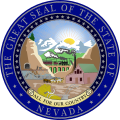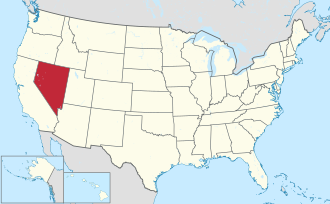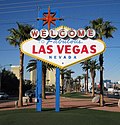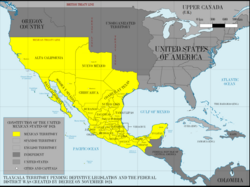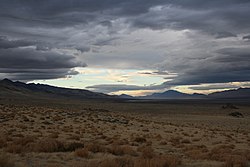Nevada
Nevada is one of the United States' states. Its capital is Carson City. The largest city is Las Vegas. Other big cities are Henderson and Reno. More than two-thirds of the people live in the Las Vegas urban area.[5]
| Nevada state symbols | |
|---|---|
 | |
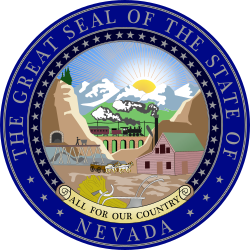 | |
| Living insignia | |
| Bird | Mountain bluebird (Sialia currucoides) |
| Fish | Lahontan cutthroat trout (Oncorhynchus clarkii henshawi) |
| Flower | Sagebrush (Artemisia tridentata) |
| Mammal | Desert bighorn sheep |
| Reptile | Desert tortoise (Gopherus agassizii) |
| Tree | Bristlecone pine (Pinus monophylla) |
| Inanimate insignia | |
| Mineral | Silver |
| Rock | Sandstone |
| Other | Element: Neon |
| State route marker | |
 | |
| State quarter | |
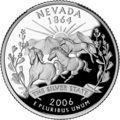 Released in 2006 | |
| Lists of United States state symbols | |
Most of Nevada is in the Great Basin. It is the driest state in the United States.[6]
Nevada was first inhabited by Native Americans. It was colonized by Spain and was part of New Spain. Later, it was part of New Mexico. It was taken by the United States in the Mexican–American War.
The most common ancestries in Nevada include Mexican, German, Irish, English, Italian and Asian.[7] Many White people and Hispanics live in the state.
History
Nevada was originally founded in 1821 as part of the First Mexican Empire. The Mexican Empire turned into the Mexican Republic in 1823, along with Nevada. Before the arrival of Europeans, Nevada was inhabited by Native American tribes including the Shoshone, the Paiute, the Washoe, and the Mohave.
The Mexican-American Conflict
Fighting between the United States and Mexico started. They fought over what was to become the Southwestern United States and who could own this land. This was called the Mexican-American War. The war ended in an American victory in 1848. Nevada later became an American territory in 1861. It was called the "Nevada Territory". This was not all of Nevada as it is today. The eastern part of Nevada was part of "Utah Territory" and the southern part was part of "New Mexico". In 1859 in the Comstock Lode, gold and silver were first discovered. This started a huge growth in mining in the state which Nevada is known for.
Gaining statehood
On October 31, 1864, now celebrated as "Nevada Day", Nevada was made the 36th state in the United States. It was given the distinct shape resembling a rectangle with a triangle. It was named Nevada meaning "snowy land" in Spanish, because it was snowy in the North. Later, on May 5, 1866, Nevada got its current borders because the Pah-Ute County in Arizona was taken as part of Nevada. It is now Clark County, Nevada. It was also agreed upon that the western part of Utah would become Eastern Nevada.
Economy
Tourism is very important to the economy of Nevada.[8] Many people visit Las Vegas, which has many casinos and resorts. There is not as much farming as there is in some other states, because Nevada is so dry. However, mining is big in Nevada. More gold is mined in Nevada than in any other state.[9]
Nevada Media
Bottle house in the mining ghost town of Rhyolite; built in 1906 with about 50,000 bottles
Mountains west of Las Vegas in the Mojave Desert
A valley near Pyramid Lake
Little Finland rock formation in Nevada
Köppen climate types of Nevada, using 1991–2020 climate normals.
Related pages
References
- ↑ "Boundary". NGS data sheet. U.S. National Geodetic Survey. http://www.ngs.noaa.gov/cgi-bin/ds_mark.prl?PidBox=HR2576. Retrieved October 20, 2011.
- ↑ 2.0 2.1 "Elevations and Distances in the United States". United States Geological Survey. 2001. Archived from the original on October 15, 2011. Retrieved October 24, 2011.
- ↑ 3.0 3.1 Elevation adjusted to North American Vertical Datum of 1988.
- ↑ "Median Annual Household Income". The Henry J. Kaiser Family Foundation. Archived from the original on December 20, 2016. Retrieved September 18, 2018.
- ↑ https://www.census.gov/programs-surveys/geography/guidance/geo-areas/urban-rural.html
- ↑ Osborn, Liz. "Driest states". Currentresults.com. Archived from the original on January 17, 2013. Retrieved January 17, 2013.
- ↑ Nevada
- ↑ "Economy of Nevada State". EconomyWatch. Archived from the original on 2010-11-04. Retrieved 2010-11-01.
- ↑ "Mineral Information Institute - Gold". Archived from the original on 2010-11-01. Retrieved 2010-11-01.
- ↑ The distinction of highest point in Nevada goes to the summit of Boundary Peak, so named because it is very near the Nevada–California border, at the northern terminus of the White Mountains. However, Boundary Peak can be considered a subsidiary summit of Montgomery Peak, whose summit is in California, since the topographic prominence of Boundary Peak is only 253 feet (77 m), which falls under the often used 300-foot (91 m) cutoff for an independent peak. Also, Boundary Peak is less than 1 mile (1.6 km) away from its higher neighbor. Hence Boundary Peak can be described as not being wholly within Nevada. By contrast, the prominence of Wheeler Peak, 13,063 feet (3,982 m), is quite large and in fact it is the twelfth largest in the contiguous United States. Wheeler Peak is the highest point in a radius of more than 200 square miles (520 km2) and is entirely within the state of Nevada.
Other websites
| Wikimedia Commons has media related to Lua error in Module:Commons_link at line 62: attempt to index field 'wikibase' (a nil value).. |
